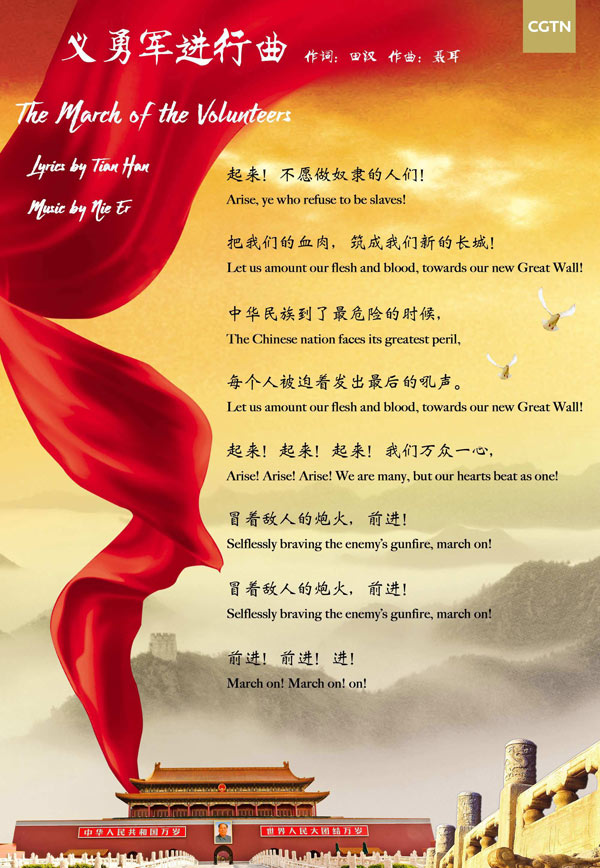


Sunday marks China’s National Day, which is also the 68th anniversary of the founding of the People’s Republic of China. In the early morning, some 100,000 people across the country gathered at the Tiananmen Square in Beijing for the flag-raising ceremony, an indispensable part of the celebrations.
Accompanied by the national anthem played by the military band, the national flag rose at 06:10 am BJT sharp, together with the sun. Over 10,000 white doves were also released at the ceremony.
The national anthem and the national flag are the most solemn symbols of a nation, and in China, playing or singing the national anthem and raising the national flag are routines done on a daily basis at Tiananmen Square, and there are always people traveling long distances to watch the ceremony.
This year’s National Day also marks the first day for the national anthem law to take effect, in order to ensure appropriate use of the song “March of the Volunteers.”
Inappropriately using the national anthem at private occasions, commercial events or as background music in public places will be taken as illegal. Violators of the law, including those who maliciously modify the lyrics or play/sing the national anthem in a distorted or disrespectful way, could be detained for up to 15 days or held criminally liable.
Meanwhile, days before the National Day, the State Administration of Press, Publication, Radio, Film, and Television also issued a notice, requiring national broadcasters including China National Radio, China Central Television and China Education Television to broadcast the national anthem at 10:00 am on important national festivals and anniversaries.
Things to learn about the Chinese national anthem and national flag
China’s national anthem, “March of the Volunteers," honors those who fought on the front during World War II against Japanese invaders in northeast China.
The song was written in 1935 by poet Tian Han with music by composer Nie Er, but it didn’t become the provisional national anthem until Sept. 27, 1949, the same day that China’s national flag and emblem were also approved.

CGTN Photo
It was officially adopted as the national anthem on Dec. 4, 1982, according to China’s central government website.
“The Chinese anthem was established during a very tumultuous period of revolution and adapted to draw people together around a common cause,” sociology professor Karen A. Cerulo of Rutgers University in the US told CGTN America during an interview.
“It is a call to arms, it invites [you] to participate, many anthems are like that. Even though it’s about a historical event, it feels more contemporary, calling for the action to continue,” he said.
The national flag of China has a red background symbolizing the spirit of revolution, one large yellow star and four smaller ones that represent golden rays radiating from a vast red land, according to the China Yearbook.
The four smaller stars, each with a corner pointing at the big yellow star, also symbolize the unity of the Chinese people under the leadership of the Communist Party of China. The design for the flag was open to a nationwide competition in 1949. Zeng Liansong’s submission was ultimately selected out of 1,920 submissions.
China has already adopted laws covering its national flag in 1990 and national emblem in 1991.
 Fire brigade in Shanghai holds group wedding
Fire brigade in Shanghai holds group wedding Tourists enjoy ice sculptures in Datan Town, north China
Tourists enjoy ice sculptures in Datan Town, north China Sunset scenery of Dayan Pagoda in Xi'an
Sunset scenery of Dayan Pagoda in Xi'an Tourists have fun at scenic spot in Nanlong Town, NW China
Tourists have fun at scenic spot in Nanlong Town, NW China Harbin attracts tourists by making best use of ice in winter
Harbin attracts tourists by making best use of ice in winter In pics: FIS Alpine Ski Women's World Cup Slalom
In pics: FIS Alpine Ski Women's World Cup Slalom Black-necked cranes rest at reservoir in Lhunzhub County, Lhasa
Black-necked cranes rest at reservoir in Lhunzhub County, Lhasa China's FAST telescope will be available to foreign scientists in April
China's FAST telescope will be available to foreign scientists in April "She power" plays indispensable role in poverty alleviation
"She power" plays indispensable role in poverty alleviation Top 10 world news events of People's Daily in 2020
Top 10 world news events of People's Daily in 2020 Top 10 China news events of People's Daily in 2020
Top 10 China news events of People's Daily in 2020 Top 10 media buzzwords of 2020
Top 10 media buzzwords of 2020 Year-ender:10 major tourism stories of 2020
Year-ender:10 major tourism stories of 2020 No interference in Venezuelan issues
No interference in Venezuelan issues
 Biz prepares for trade spat
Biz prepares for trade spat
 Broadcasting Continent
Broadcasting Continent Australia wins Chinese CEOs as US loses
Australia wins Chinese CEOs as US loses